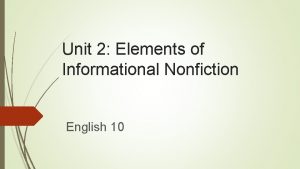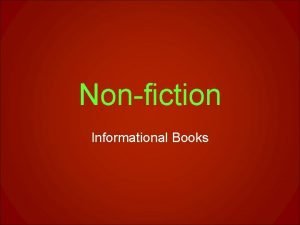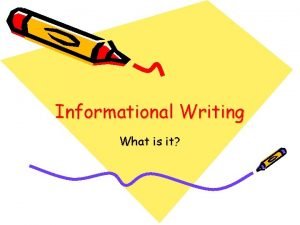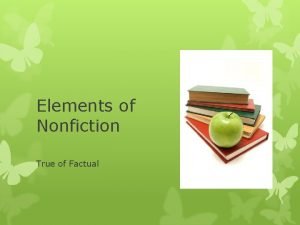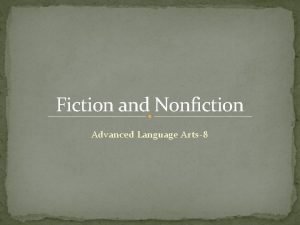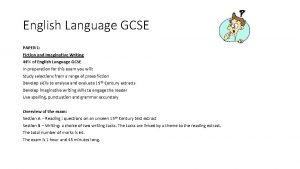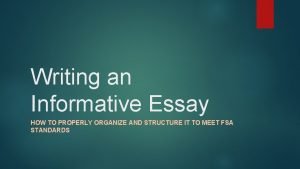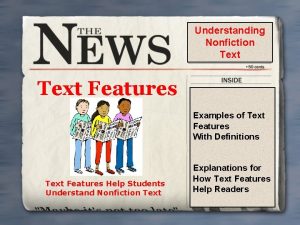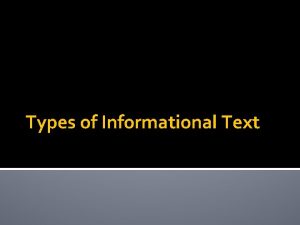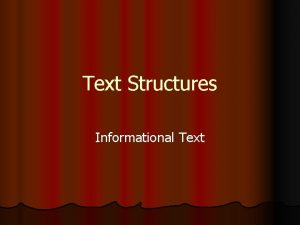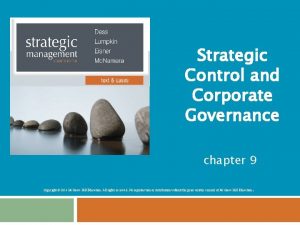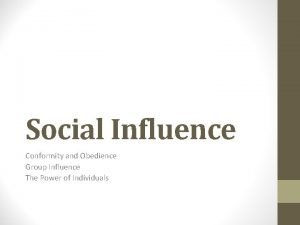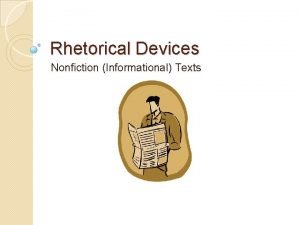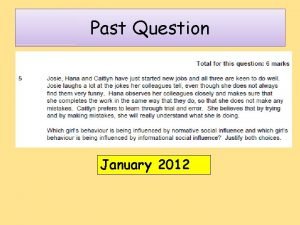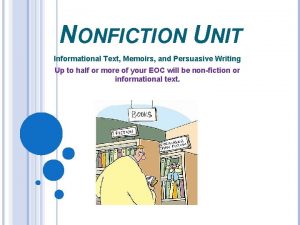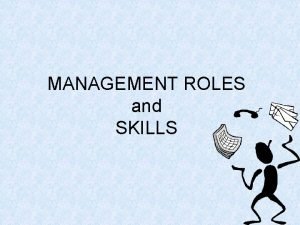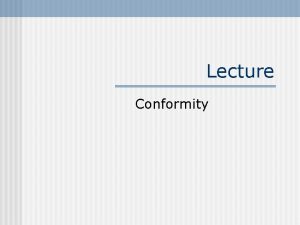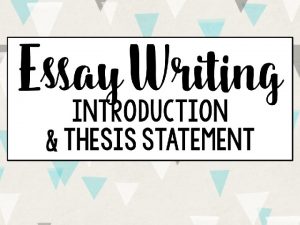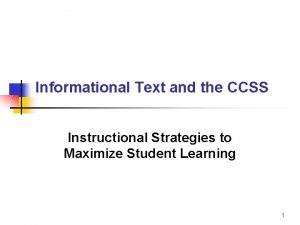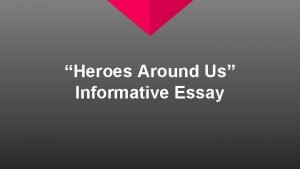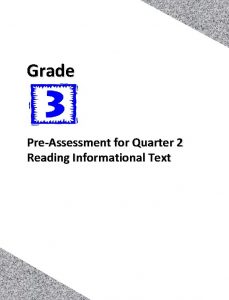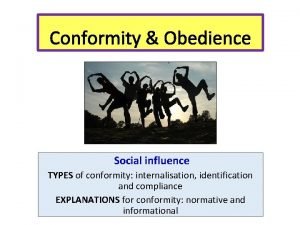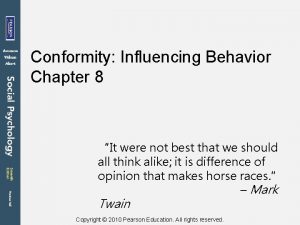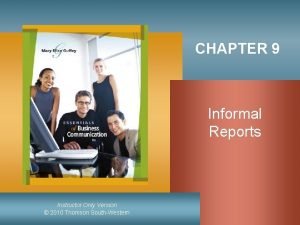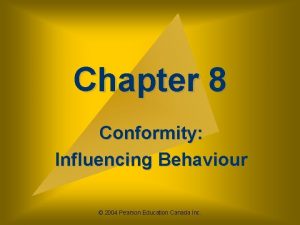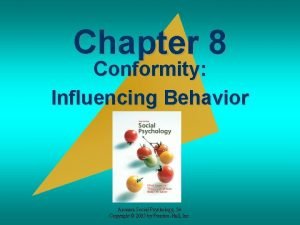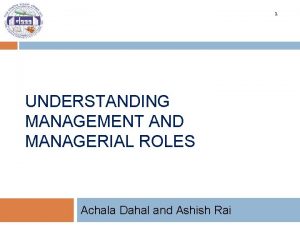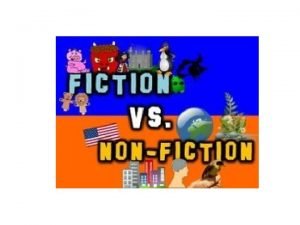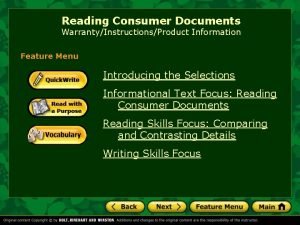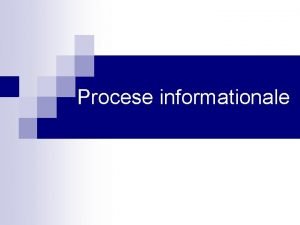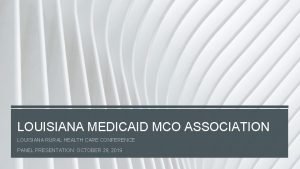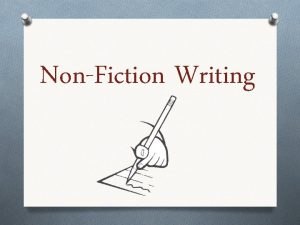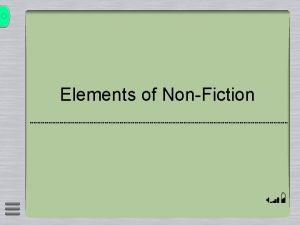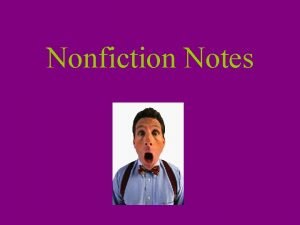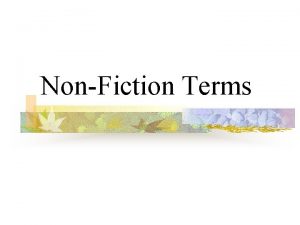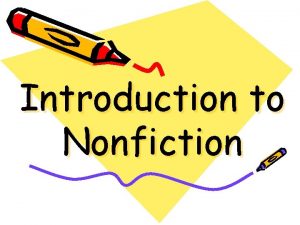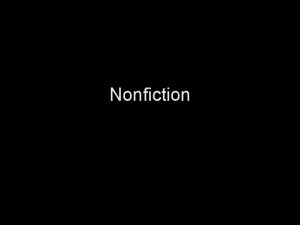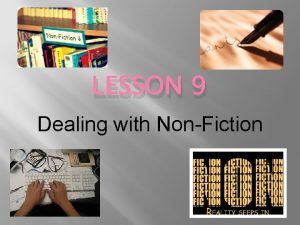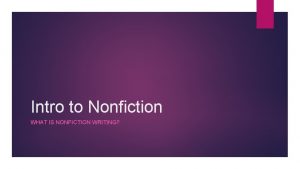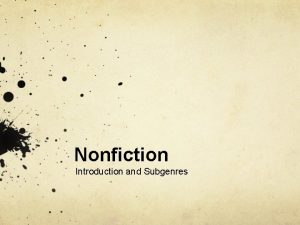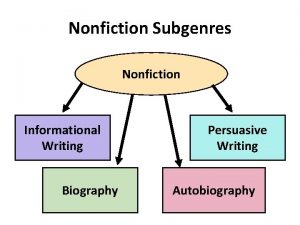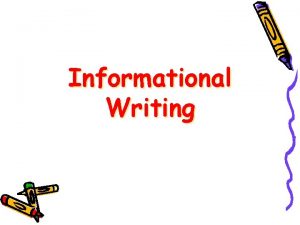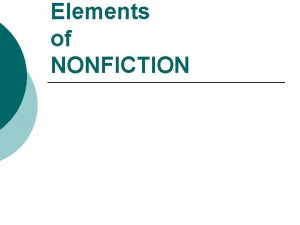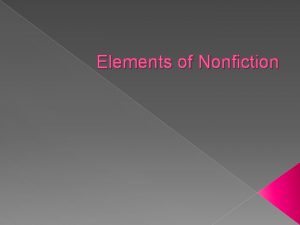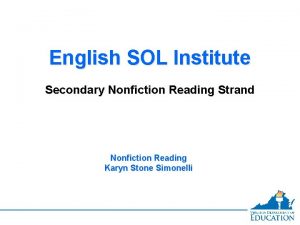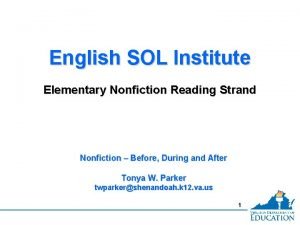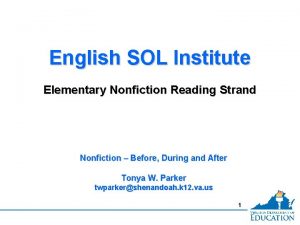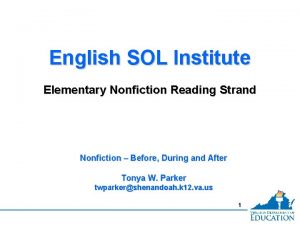Unit 2 Elements of Informational Nonfiction English 10














































- Slides: 46

Unit 2: Elements of Informational Nonfiction English 10

Introduction to Informational Texts Objective In this lesson, you will evaluate the function and features of informational nonfiction texts.

Introduction to Informational Texts For informational texts, the main purpose is to inform readers about a subject. If a text's primary aim is to inform readers, it must contain facts, descriptions, or instructions, although it may also include opinions and arguments.

Introduction to Informational Texts Two major subcategories of informational text: expository texts and functional texts Expository texts are informational texts that serve to introduce readers to a topic and describe or explain it at length. It presents information using a common structure. These texts are organized so that readers can find what they're looking for easily. The table of contents, index, section headings, and image captions are some features that aid readers in expository texts. So are graphs, charts, and other info graphics. The subject of an expository text is not usually personal

Introduction to Informational Texts Functional texts provide information to help perform everyday tasks. Functional texts use simple and direct language so that readers can grasp the content with as little effort as possible. Like expository texts, functional texts help readers locate information. They may also use images to illustrate steps in a procedure. However, functional texts do not contain opinions or value judgments. Advertisements, applications, brochures, recipes, pamphlets, announcements, office memos, guidelines, and "how-to" notes are all examples of functional texts.

Introduction to Informational Texts Examples of functional texts: Directions for how to resize the graphics for a computer program or document An exercise training schedule chart A tourists’ guidebook to a specific city Examples of expository texts: A brief history of the yo-yo A short explanation of the connection between the noble class of the middle ages, arsenic, and white hair An explanation of Sir Isaac Newton’s law of universal gravitation

Introduction to Informational Texts This excerpt provides information about the Roman Empire. Which sentence in the excerpt speak about the purpose of the text? The History of the Decline and Fall of the Roman Empire by Edward Gibbon (excerpt) In the second century of the Christian era, the empire of Rome comprehended the fairest part of the earth, and the most civilized portion of mankind. The frontiers of that extensive monarchy were guarded by ancient renown and disciplined valor. The gentle but powerful influence of laws and manners had gradually cemented the union of the provinces. Their peaceful inhabitants enjoyed and abused the advantages of wealth and luxury. The image of a free constitution was preserved with decent reverence: the Roman senate appeared to possess the sovereign authority, and devolved on the emperors all the executive powers of government. During a happy period of more than fourscore years, the public administration was conducted by the virtue and abilities of Nerva, Trajan, Hadrian, and the two Antonines. It is the design of this, and of the two succeeding chapters, to describe the prosperous condition of their empire; and after wards, from the death of Marcus Antoninus, to deduce the most important circumstances of its decline and fall; a revolution which will ever be remembered, and is still felt by the nations of the earth.

Introduction to Informational Texts This excerpt provides information about the Roman Empire. Which sentence in the excerpt speak about the purpose of the text? The History of the Decline and Fall of the Roman Empire by Edward Gibbon (excerpt) In the second century of the Christian era, the empire of Rome comprehended the fairest part of the earth, and the most civilized portion of mankind. The frontiers of that extensive monarchy were guarded by ancient renown and disciplined valor. The gentle but powerful influence of laws and manners had gradually cemented the union of the provinces. Their peaceful inhabitants enjoyed and abused the advantages of wealth and luxury. The image of a free constitution was preserved with decent reverence: the Roman senate appeared to possess the sovereign authority, and devolved on the emperors all the executive powers of government. During a happy period of more than fourscore years, the public administration was conducted by the virtue and abilities of Nerva, Trajan, Hadrian, and the two Antonines. It is the design of this, and of the two succeeding chapters, to describe the prosperous condition of their empire; and after wards, from the death of Marcus Antoninus, to deduce the most important circumstances of its decline and fall; a revolution which will ever be remembered, and is still felt by the nations of the earth.

Introduction to Informational Texts What is the purpose of this excerpt from the article "What Is GIS? "? GIS also can be used for complex modeling to answer a wide range of "what if" and ecosystem simulation questions. These may be cartographic models designed to document the co-occurrence or interrelationship of multiple data layers or they may be hypothetical research models designed to mimic natural ecological systems. Similarly, modeling with GIS can be used to predict the impacts that one set of parameters will have on another. For example, wetlands, soils, hydrography, climatology and elevation data can be combined to model flooding within a river system. Upstream changes in land use within the same system can be modeled to determine the potential impact of conversion of a forested floodplain to residential development or to agriculture. As a result, both natural system responses to storm events and the impact of human land use decisions can be assessed prior to the proposed action. to warn readers about the hazards of diminishing wetlands to inform readers about the multiple uses of GIS to explain the workings of the ecosystem simulations to instruct readers about proper use of GIS resources

Introduction to Informational Texts What is the purpose of this excerpt from the article "What Is GIS? "? GIS also can be used for complex modeling to answer a wide range of "what if" and ecosystem simulation questions. These may be cartographic models designed to document the co-occurrence or interrelationship of multiple data layers or they may be hypothetical research models designed to mimic natural ecological systems. Similarly, modeling with GIS can be used to predict the impacts that one set of parameters will have on another. For example, wetlands, soils, hydrography, climatology and elevation data can be combined to model flooding within a river system. Upstream changes in land use within the same system can be modeled to determine the potential impact of conversion of a forested floodplain to residential development or to agriculture. As a result, both natural system responses to storm events and the impact of human land use decisions can be assessed prior to the proposed action. to warn readers about the hazards of diminishing wetlands to inform readers about the multiple uses of GIS to explain the workings of the ecosystem simulations to instruct readers about proper use of GIS resources

Introduction to Informational Texts Dorothea Lange believed it was important to record what her subjects said. She noted their exact words whenever she could, and sent them with the accompanying photographs to the government. One of Lange's best-known photographs is Migrant Mother. Lange met this woman and her children on a rainy day in March 1936. How does the photograph enhance the information in the passage?

Introduction to Informational Texts 1) The picture emphasizes the intention of the photographer to tell the world about the miseries faced by migrants. 2) The picture highlights the photographer's skills in capturing the perfect emotion on the woman's face. 3) The picture shows the inability of the farmhands to find steady employment. 4) The picture supports the aim of the photographer to capture vivid emotions of women. 5) The picture is part of a collaborative effort to raise funds for women, as mentioned in the text.

Introduction to Informational Texts 1) The picture emphasizes the intention of the photographer to tell the world about the miseries faced by migrants. 2) The picture highlights the photographer's skills in capturing the perfect emotion on the woman's face. 3) The picture shows the inability of the farmhands to find steady employment. 4) The picture supports the aim of the photographer to capture vivid emotions of women. 5) The picture is part of a collaborative effort to raise funds for women, as mentioned in the text.

Introduction to Informational Texts Other Types of Informational Texts Most news articles are informational texts. Their purpose is to supply readers with factual details or an editorial opinion on important events. Short biographical notes are also informational texts. They mainly focus on the facts of a person's life, but they do not convey opinions or evaluate the person's actions. Historical texts are a special type of expository text. Historians not only present evidence and facts but also interpret that information to build a coherent picture of the past. Science texts for general readers and students are expository texts that present facts, principles, theories, and reasoning.

Introduction to Informational Texts In the following passage from Great Astronomers by Robert Stewall Ball, the author states that he will trace the developments in astronomy from the time of Ptolemy to the nineteenth century. Based on the content and style of the excerpt, what kind of audience did Ball primarily have in mind when he was writing this book? The history of astronomy thus becomes inseparable from the history of the great men to whose labours its development is due. In the ensuing chapters we have endeavoured to sketch the lives and the work of the great philosophers, by whose labours the science of astronomy has been created. We shall commence with Ptolemy, who, after the foundations of the science had been laid by Hipparchus, gave to astronomy the form in which it was taught throughout the Middle Ages. We shall next see the mighty revolution in our conceptions of the universe which are associated with the name of Copernicus. We then pass to those periods illumined by the genius of Galileo and Newton, and afterwards we shall trace the careers of other more recent discoverers, by whose industry and genius the boundaries of human knowledge have been so greatly extended. Our history will be brought down late enough to include some of the illustrious astronomers who laboured in the generation which has just passed away. people with a casual interest in astronomy

Focus on Language Let’s look at a few words that you came across while reading passages from Great Astronomers. Word diligent (adj. ) Definitions Pronunciation Synonyms Antonym careful about one's work DIH-luh-juhnt industrious negligent celestial (adj. ) relating to the sky suh-LEHS-chuhl protracted (adj. )unduly long, extended proh-TRACT-ehd conjectured (v. ) heavenly earthly extended curtailed formed an opinion without enough support kuhn-JEHK-churd surmised erroneous (n. ) wrong ih-ROHN-ee-uhs wrong verisimilitude (n. ) veh-rih-suh-MIH-luh-tood validity (n. ) similarity to the truth quality of being acceptable vuh-LIH-duh-tee guessed — accurate — legitimacy invalidity interposing (adj. )situated between two things ihn-tuhr-POHZ-ihng — — sagacity (n. ) wisdom, insight adduce (v. ) provide as evidence to support an argument suh-GA-suh-tee uh-DOOS cite foolishness —

Focus on Language Using Words in Context Select the words from the vocabulary list that would best complete the sentences. The lawsuit ran for more than five years. At first, the case appeared to be going against the client. Yet the lawyer _____ valuable testimony to convince the jury of her client's innocence at the end of the ______ legal battle.

Focus on Language Using Words in Context Select the words from the vocabulary list that would best complete the sentences. The lawsuit ran for more than five years. At first, the case appeared to be going against the client. Yet the lawyer adduced valuable testimony to convince the jury of her client's innocence at the end of the protracted legal battle.

Opinion in Informational Texts Objective: In this lesson, you will analyze opinion, bias, and persuasive techniques in informational texts.

Opinion in Informational Texts Persuasive Techniques The main purpose of a persuasive text is to win readers over to one side of an issue or to sway the reader’s opinion. An advertisement would be one example of persuasive text. a

Opinion in Informational Texts Persuasive Techniques Argumentative texts also aim to establish an opinion, but their approach is usually more balanced. They examine opposing viewpoints and factual data. (The acknowledgement of an opposing view is not found in persuasive texts. ) A scientific article that presents both opposing views and accepted facts is an argumentative text designed to persuade. also

Opinion in Informational Texts Rhetorical Techniques are used by both persuasive and argumentative texts to support a viewpoint. 1) emotional appeal - It sways readers by discussing a topic that raises strong emotions. An example is an advertisement for a charity that asks donors to "save a child from starvation today. " 2) ethical appeal - It convinces an audience that the writer is sympathetic to the issue and worthy of attention and respect. It then uses that positive impression to persuade the audience.

Opinion in Informational Texts Rhetorical Techniques 3) appeal to logic - The writer presents an opinion with supporting facts and then arrives at a conclusion through reasoning. 4) citing expert opinion - Writers using this technique present the viewpoint of someone with special qualifications to back their claims. For example, advertisements often cite expert opinion product. to promote a

Opinion in Informational Texts Rhetorical Techniques Bandwagon - involves persuading the audience to do something because many other people are doing it example: Millions of satisfied customers have chosen our products for their flooring needs. Place your order today. Celebrity endorsements - way of gaining support for a product, service, or social or political cause. When celebrities support a product or cause, some of their fans will follow suit.

Opinion in Informational Texts Rhetorical Techniques Association - creates a subtle but strong connection in the audience's mind between an opinion the writer wants to push and something the audience already values. example: an advertisement might associate a sunny beach with a new product it’s trying to sell. Association is the persuasive technique that is often used to create brand loyalty by linking a product to something positive. This technique connects the product to desirable notions such as loyalty, beauty, and togetherness.

Opinion in Informational Texts Bias occurs when an author makes a judgment based on a personal point of view and attempts to persuade the audience unfairly to share that view. It’s important to recognize evidence of bias as you read a text because bias can indicate that the author’s claims are inaccurate or unfair. Writers can employ persuasive techniques in a way that unfairly influences the audience's view a topic. Often, biased texts also use faulty reasoning.

Opinion in Informational Texts Which line or lines in this editorial show faulty reasoning? Save Teenage Driving: A Call to Arms an editorial by Sophie Behrend Recently, House Representative Ken Weaver of Washington State proposed a bill (House Bill R-9687 b) that would raise the legal driving age to 21. You heard me right— Congress is considering raising the driving age to 21. If you are like me, such a law would be a catastrophe and would only mean one thing: the end of life as we know it. Representative Weaver claims that his bill is motivated by "safety. " He argues, “Nearly half of all accidents involve people under the age of 21. " Representative Weaver also claims, "Raising the driving age would mean raising the level of safety on America's roads. " But I would ask Representative Weaver: Do not "nearly half" of all accidents involve men, and would not the streets be safer, then, if male drivers were outlawed? And what about the percentage of accidents that occur on paved roads—should we do away with paved roads too?

Opinion in Informational Texts Which line or lines in this editorial show faulty reasoning? Save Teenage Driving: A Call to Arms an editorial by Sophie Behrend Recently, House Representative Ken Weaver of Washington State proposed a bill (House Bill R-9687 b) that would raise the legal driving age to 21. You heard me right— Congress is considering raising the driving age to 21. If you are like me, such a law would be a catastrophe and would only mean one thing: the end of life as we know it. Representative Weaver claims that his bill is motivated by "safety. " He argues, “Nearly half of all accidents involve people under the age of 21. " Representative Weaver also claims, "Raising the driving age would mean raising the level of safety on America's roads. " But I would ask Representative Weaver: Do not "nearly half" of all accidents involve men, and would not the streets be safer, then, if male drivers were outlawed? And what about the percentage of accidents that occur on paved roads—should we do away with paved roads too?

Opinion in Informational Texts Logical Fallacies Some types of faulty reasoning are called logical fallacies. They involve making arguments in an unfair way. Logical fallacies occur when a writer attempts to make a claim that uses illegitimate arguments, makes irrelevant points, or lacks proper evidence.

Opinion in Informational Texts Persuasive techniques can appear in a variety of texts, including public relations documents, project proposals, political campaign speeches, and appeals for charity. In other informational texts, the writer's efforts to persuade readers may be subtler. An example of this type of text is a scientific text that offers a perspective on a field of study or a new theory. You should be aware that not all writers who quote scientific facts have scientifically valid arguments.

Opinion in Informational Texts Of the two paragraphs in this excerpt from the article "The Melting Arctic" from the European Environmental Agency, which one relies on expert opinion to support the organization's point of view? 1)Greenland's ice sheet contains enough water to increase global sea levels by 7 meters. In any case, if it were to melt completely, it would take many centuries. Recent melting of the Greenland ice sheet is estimated to have contributed up to 0. 7 millimeters a year to sea level rise (about one quarter of the total global average sea level rise of about 3. 1 mm/year). Projections for global average sea level rise estimates by 2100 vary from 0. 2 to 2. 0, depending on the model and scenario used. 2)"There is substantial uncertainty around by how much the sea levels may actually increase, " said Professor David Vaughan from the British Antarctic Survey during his presentation. "Once sea level rises, it is quite difficult to make it fall again. At the moment, the sea level is increasing by about 3 mm per year, but with climate change, this rate is very likely to increase. "

Opinion in Informational Texts Of the two paragraphs in this excerpt from the article "The Melting Arctic" from the European Environmental Agency, which one relies on expert opinion to support the organization's point of view? 1)Greenland's ice sheet contains enough water to increase global sea levels by 7 meters. In any case, if it were to melt completely, it would take many centuries. Recent melting of the Greenland ice sheet is estimated to have contributed up to 0. 7 millimeters a year to sea level rise (about one quarter of the total global average sea level rise of about 3. 1 mm/year). Projections for global average sea level rise estimates by 2100 vary from 0. 2 to 2. 0, depending on the model and scenario used. 2)"There is substantial uncertainty around by how much the sea levels may actually increase, " said Professor David Vaughan from the British Antarctic Survey during his presentation. "Once sea level rises, it is quite difficult to make it fall again. At the moment, the sea level is increasing by about 3 mm per year, but with climate change, this rate is very likely to increase. "

Opinion in Informational Texts In this excerpt from a video transcript, which sentences demonstrate the use of emotional appeal as a persuasive technique? NARRATOR: As Arctic ice continues to melt, it will cause ripple effects across the planet. When the polar regions warm, even just a degree, it disturbs atmospheric and oceanic patterns. The patterns of the jet stream will be affected, which may lead to more extreme summer and winter weather events in Europe, Asia, and North America. Not only will our weather change, but sea level will rise too. Sea ice melt itself does not cause sea levels to rise because the ice is already in the water. But the melting of ice on a land surface, like Greenland, does because new water is flowing into the ocean. In addition, as ocean water warms, it expands, which also raises sea level. Warmer air temperatures will accelerate the melting of Greenland’s ice sheet, which contains enough ice to raise global sea levels by more than 20 feet. Sea ice creates a unique ecosystem that supports millions of plants and animals, from krill and ice algae to cod and walruses. Both the topside and underside of the ice provides places for the animals to hunt, hide, rest, mate, and give birth. Without sea ice, arctic plants and animals must either adapt or migrate. If they can’t, they will go extinct. If that isn’t enough, people who live in coastal communities within the Arctic Circle are also battling erosion along their coastlines. Sea ice serves as a buffer against wave action. Without it, the wind blows across a larger region of open water, resulting in stronger winds and bigger waves that erode the shoreline. These communities must relocate inland or their homes and land could be washed out to sea. For ice in the Arctic, it’s a race against time. If humans do not change what we are doing to the global climate, the ice will continue to disappear and life as we know it will be altered.

Opinion in Informational Texts In this excerpt from a video transcript, which sentences demonstrate the use of emotional appeal as a persuasive technique? NARRATOR: As Arctic ice continues to melt, it will cause ripple effects across the planet. When the polar regions warm, even just a degree, it disturbs atmospheric and oceanic patterns. The patterns of the jet stream will be affected, which may lead to more extreme summer and winter weather events in Europe, Asia, and North America. Not only will our weather change, but sea level will rise too. Sea ice melt itself does not cause sea levels to rise because the ice is already in the water. But the melting of ice on a land surface, like Greenland, does because new water is flowing into the ocean. In addition, as ocean water warms, it expands, which also raises sea level. Warmer air temperatures will accelerate the melting of Greenland’s ice sheet, which contains enough ice to raise global sea levels by more than 20 feet. Sea ice creates a unique ecosystem that supports millions of plants and animals, from krill and ice algae to cod and walruses. Both the topside and underside of the ice provides places for the animals to hunt, hide, rest, mate, and give birth. Without sea ice, arctic plants and animals must either adapt or migrate. If they can’t, they will go extinct. If that isn’t enough, people who live in coastal communities within the Arctic Circle are also battling erosion along their coastlines. Sea ice serves as a buffer against wave action. Without it, the wind blows across a larger region of open water, resulting in stronger winds and bigger waves that erode the shoreline. These communities must relocate inland or their homes and land could be washed out to sea. For ice in the Arctic, it’s a race against time. If humans do not change what we are doing to the global climate, the ice will continue to disappear and life as we know it will be altered.

Audience in Informational Texts Objective: In this lesson, you will examine how audience can influence an informational text. Audience refers to the people who read a text, hear a speech or concert, or view a painting or other work of visual art.

Audience in Informational Texts Two types of audiences exist: real and intended. The real audience is the people who actually read the text. A teacher, friend, or tutor can be the real audience because they are the ones who read the content. The intended audience is the people whom your letter or speech addresses or the ones you intend to hear your message.

Audience in Informational Texts Let's say that your teacher has assigned you to write a letter to the local town council requesting a stop sign at an intersection in your neighborhood. Your intended audience for this letter will be the town council. But your teacher will be the real audience because he or she reads your essay to grade it.

Audience in Informational Texts Knowing your intended audience can help you decide the following: what information to include how to arrange that information what background information to add how to adjust the tone the best word choice the most appropriate structure Effective writing will also appeal to the intended audience. The audience determines if you use logical, emotional, or ethical appeals in your writing.

Audience in Informational Texts The difference between a personal letter and a business letter includes tone, language, and formatting. A personal letter is considered informal because it likely uses casual words and phrases, a comma after the salutation, emoticons, and informal metaphors. A business letter, however, is written using formal and technical language. It is not offensive, but polite and firm. Also, the formatting is professional, as the header consists of the sender and recipient's address. A colon rather than a comma follows the salutation.

Audience in Informational Texts Morgan will be going to college soon. When he looks up a college website to research tuition fees, he finds the costs to be unreasonably high. He decides to write a letter to a local government representative about the high tuition fees. What kind of letter should Morgan draft? sarcastic, irreverent, and mocking direct, harsh, and indignant formal, clear, and courteous ambivalent, apathetic, and flat

Audience in Informational Texts Explanation: A government representative holds a position of authority. When you write to someone in such a position, the tone of the letter should be polite and respectful.

Audience in Informational Texts After reading Abraham Lincoln’s First Inaugural Address, answer the following questions. Who is the intended audience? Do you think the audience’s emotional state influenced Lincoln's speech? How did the audience influence the speech’s tone and purpose?

Audience in Informational Texts In his inaugural speech, President Lincoln is primarily addressing American citizens, the people who make up the Union. He specifically speaks to Southerners who have seceded from the Union and people in states that are planning to secede. He may also be addressing the international community, particularly the country's allies, to reassure them.

Audience in Informational Texts Lincoln’s tone is evident in his speech. Be able to identify tone in various sections of his speech.

Audience in Informational Texts Review the Focus on Language section in Unit 2: Audience in Informational Text section. Be able to identify and use parallel structure correctly.

 How did the passage
How did the passage Informational nonfiction books
Informational nonfiction books What is informational writing
What is informational writing Factual/nonfictional aspects
Factual/nonfictional aspects Elements of nonfiction narrative
Elements of nonfiction narrative Elements of nonfiction quiz
Elements of nonfiction quiz Elements of nonfiction
Elements of nonfiction Elements of fiction and nonfiction
Elements of fiction and nonfiction English fiction and imaginative writing
English fiction and imaginative writing English unit conversion
English unit conversion Unit 6 review questions
Unit 6 review questions Informative essay guide
Informative essay guide Informational influence
Informational influence Informational texts examples
Informational texts examples Types of informational text
Types of informational text Informational text structure
Informational text structure Strategic control
Strategic control Normative social influence
Normative social influence Retorical device
Retorical device Examples of informational social influence
Examples of informational social influence Media and information economic opportunities
Media and information economic opportunities Informational social influence example
Informational social influence example Persuasive non fiction
Persuasive non fiction Figurehead role
Figurehead role Informational conformity definition
Informational conformity definition What is an informational essay
What is an informational essay Comparing informational texts
Comparing informational texts Anticipation guide examples
Anticipation guide examples Informational infographic
Informational infographic Informative essay examples
Informative essay examples Chapter 2 reading informational text answer key
Chapter 2 reading informational text answer key Fluxul informațional reprezintă:
Fluxul informațional reprezintă: Internalisation conformity
Internalisation conformity Normative conformity example
Normative conformity example What is normative influence
What is normative influence Indirect-pattern analytical reports end with
Indirect-pattern analytical reports end with Informational social influence
Informational social influence Informative conformity example
Informative conformity example Informational role of manager
Informational role of manager Conclusion informational writing
Conclusion informational writing Topic sentence starters for informational writing
Topic sentence starters for informational writing How to summarize a nonfiction text
How to summarize a nonfiction text Referent informational influence
Referent informational influence Consumer document
Consumer document Procese informationale
Procese informationale Componentele sistemului informational
Componentele sistemului informational Ldh informational bulletins
Ldh informational bulletins
